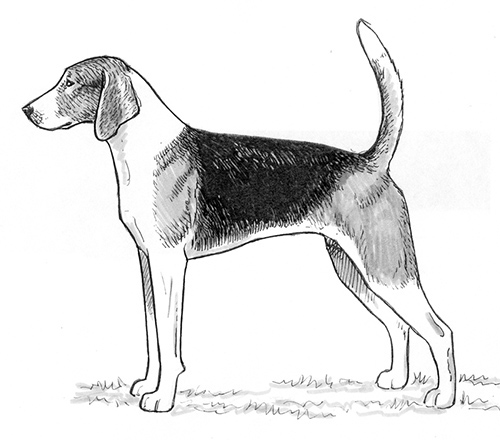American Foxhound
Scenthound Group
The goals and purposes of this breed standard include: to furnish guidelines for breeders who wish to maintain the quality of their breed and to improve it; to advance this breed to a state of similarity throughout the world; and to act as a guide for judges.
Breeders and judges have the responsibility to avoid any conditions or exaggerations that are detrimental to the health, welfare, essence and soundness of this breed, and must take the responsibility to see that these are not perpetuated.
Any departure from the following should be considered a fault, and the seriousness with which the fault should be regarded should be in exact proportion to its degree and its effect upon the health and welfare of the dog and on the dog’s ability to perform its traditional work.
History
As its name suggests, the American Foxhound was developed in colonial America, using the English Foxhound as a base. Irish, French and other hounds are thought to have been used in the breed's refinement.
The American Foxhound was recognized by the United Kennel Club in 1905.
Head
The head is fairly long.
SKULL
The skull is slightly domed at the occiput. The cranium is broad and full. The stop is moderately defined.
MUZZLE
The straight, square cut muzzle is of fair length.
Faults: Very flat skull. Skull narrow across the top. Excess of dome. Long, snipey muzzle. Cut away decidedly below the eyes. Very short muzzle. Roman-nosed. Upturned nose.
EYES
The large eyes are brown or hazel in color. They are set well apart, and have a soft, hound-like expression that is gentle and pleading.
Faults: Small, sharp, terrier-like eyes. Prominent, protruding eyes.
EARS
The ears are set on moderately low, are almost absent of any erectile power, and set close to the head, with the forward edge slightly in-turning to the cheek. They are long enough that if drawn out they nearly, if not quite, reach the tip of the nose. The fairly broad ears are round at the tip.
Faults: Short ears. Set on high. Tendency to rise above he point of origin.
Neck
The clean, medium length neck rises free and light from the shoulders. It is strong in substance, but not loaded. A slight wrinkle below the angle of the jaw is allowed.
Faults: Thick, short, cloddy neck carried on a line with the top of the shoulders. Dewlap and skin folds to a degree that may be termed “throatinessâ€.
Forequarters
FORELEGS
The straight forelegs have a fair amount of bone. The elbows point straight back, being neither in nor out. The short pasterns are straight.
Faults: Crooked forelegs. Knees knuckled forward, or bent backward. Straight, upright shoulders.
Body
The clean, muscular, sloping shoulders convey the idea of freedom and action combined with activity and strength. The moderately long back is muscular and strong. The broad loins are slightly arched. The chest is deep to allow for lung space, but is narrower in proportion to depth than that of the English Foxhound. A 23-inch Hound having a 28-inch girth is ideal. The back ribs extending well back. A three-inch flank allows for springiness.
Faults: Very long back. Swayed back. Roach back. Flat, narrow loins. Chest disproportionately wide. Lack of depth in chest.
Hindquarters
The strong, muscular hips and thighs provide abundant propelling power.
HIND LEGS
The strong stifles are well let down. The firm, strong stifles are well let down. The firm, symmetrical hocks are moderately bent.
Faults: Cow hocks. Straight hocks. Lack of muscle and propelling power.
Feet
The close, firm, fox-like feet have full, hard pads, well-arched toes and strong nails.
Faults: Long, open or spreading feet.
Tail
The tail is set moderately high. It is carried gaily with a slight curve, but is not turned forward over the back.
Faults: Long tail. Teapot curve. Inclined forward from the root. Rat tail.
Coat
The close, hard Hound coat is of medium length. The tail has a very slight brush.
Faults: Short, thin coat. Soft coat. Entire absence of brush from tail.
Color
Any color is acceptable.
Height
Height is measured at the point of the withers, with the hound standing in a natural position with its feet well under. Height ranges are: Males should not be under 22 inches or over 25 inches. Females should not be under 21 inches or over 24 inches.
Faults
All faults are to be evaluated in relation to their degree of deviation from the ideal.
Disqualifications
(A dog with a Disqualification must not be considered for placement in a conformation event, and must be reported to UKC.)
Unilateral or bilateral cryptorchid.
Viciousness or extreme shyness.
Albinism.

Looking for a Dog?
Find a dog that will fit your family.
Note: The breeders on this list are not endorsed by UKC.
Revised January 1, 2009
©Copyright 1992, United Kennel Club
